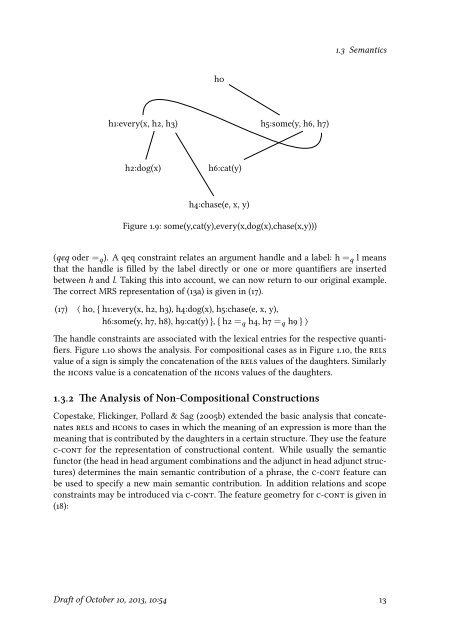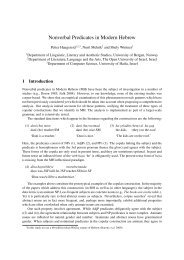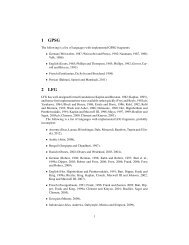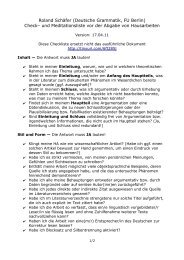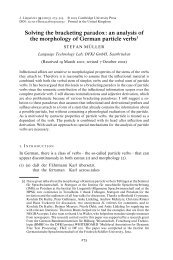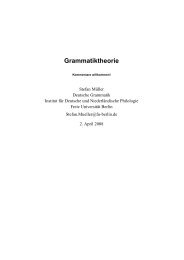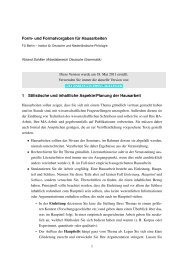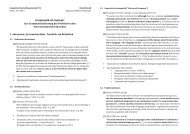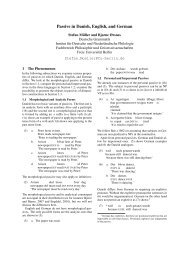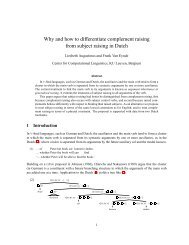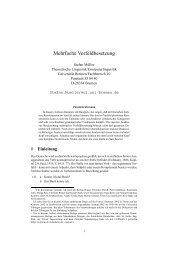- Page 1: Danish in Head-Driven Phrase Struct
- Page 4 and 5: e Project is book is part of a larg
- Page 6 and 7: has object agreement. Since German
- Page 8 and 9: Danish Danish is a North-Germanic l
- Page 10 and 11: the World Wide Web are used. Our ex
- Page 12 and 13: A Note on the Way this Book is Publ
- Page 14 and 15: Contents . e Analysis . . . . . . .
- Page 16 and 17: Contents .. Passivization of Result
- Page 18 and 19: Contents . Conclusion . . . . . . .
- Page 20 and 21: A Brief Introduction to HPSG four c
- Page 22 and 23: A Brief Introduction to HPSG exampl
- Page 24 and 25: A Brief Introduction to HPSG . NP.
- Page 26 and 27: A Brief Introduction to HPSG e lis
- Page 28 and 29: A Brief Introduction to HPSG e head
- Page 32 and 33: A Brief Introduction to HPSG V[ ⟨
- Page 34 and 35: A Brief Introduction to HPSG c. CAU
- Page 36 and 37: A Brief Introduction to HPSG () Lex
- Page 39 and 40: A topological model of the Danish c
- Page 41 and 42: . e topological model makes lile se
- Page 43 and 44: . V -clauses and V -clauses b. fo
- Page 45 and 46: . V -clauses and V -clauses () ()
- Page 47 and 48: . A topological model a Prefield an
- Page 49 and 50: . A topological model Prefield T/C
- Page 51 and 52: . A topological model aer the adver
- Page 53 and 54: . A topological model If the consti
- Page 55 and 56: . A topological model e adverb deri
- Page 57 and 58: . A topological model Finally, inhe
- Page 59 and 60: . Inadequacies of the topological m
- Page 61 and 62: . Inadequacies of the topological m
- Page 63 and 64: . Other Languages Prefield T/C Sent
- Page 66 and 67: Object Shi and Negation Shi In Chap
- Page 68 and 69: . e Phenomenon In a similar vein an
- Page 70 and 71: . e Phenomenon e exact restrictions
- Page 72 and 73: . e Phenomenon () Jeg sover [her] i
- Page 74 and 75: . e Phenomenon Also it is impossibl
- Page 76 and 77: . e Phenomenon () a. at han ikke [f
- Page 78 and 79: . e Phenomenon () a. ? [Foræret] h
- Page 80 and 81:
. e Phenomenon For these reasons we
- Page 82 and 83:
. e Phenomenon () a. Mærkeligt ogs
- Page 84 and 85:
. e Phenomenon elements like finite
- Page 86 and 87:
. e Phenomenon () a. fordi vi så s
- Page 88 and 89:
. e Phenomenon .. Parasitic Gaps an
- Page 90 and 91:
. e Analysis () Mapping from to va
- Page 92 and 93:
. e Analysis S NP S/NP V⟨ S//VP
- Page 94 and 95:
. e Analysis b. give with shied ind
- Page 96 and 97:
. e Analysis S NP S/NP V⟨ S//VP
- Page 98 and 99:
. e Analysis .. Shiing and Preposit
- Page 100 and 101:
. e Analysis S VP[ ⟨ 1 , 2 ⟩] S
- Page 102 and 103:
. e Analysis ⎡ [ ] ⎤ pass ver
- Page 104 and 105:
. e Analysis S NP S/NP V⟨ S//V
- Page 106 and 107:
. e Analysis S VP[ ⟨ 1 , 2 ⟩] S
- Page 108 and 109:
. Alternatives b. Kender Peter [hen
- Page 110 and 111:
. Alternatives () Hun kender [ham]
- Page 112 and 113:
. Alternatives CP C IP NP VP NP VP
- Page 114 and 115:
. Alternatives movement analysis on
- Page 116 and 117:
. Alternatives () a. Jeg har I have
- Page 118 and 119:
. Alternatives CP[ ⟨ m:at, n:Jens
- Page 120 and 121:
. Alternatives within the VP (V ).
- Page 122:
. Conclusion to the list and then
- Page 125 and 126:
Copula Constructions c. Sylvia is [
- Page 127 and 128:
Copula Constructions like Danish: D
- Page 129 and 130:
Copula Constructions b. * at klog e
- Page 131 and 132:
Copula Constructions found in Bech
- Page 133 and 134:
Copula Constructions . e Analysis .
- Page 135 and 136:
Copula Constructions () ⎡ | ⎡
- Page 137 and 138:
Copula Constructions Sema (Predica
- Page 139 and 140:
. Copula Constructions Vs1[ ⟨
- Page 141 and 142:
Copula Constructions e noun mayor i
- Page 143 and 144:
Copula Constructions . V[ . ⟨⟩
- Page 145 and 146:
Copula Constructions adjective phra
- Page 147 and 148:
Copula Constructions V s [ ⟨ .
- Page 149 and 150:
Copula Constructions treat specific
- Page 151 and 152:
Copula Constructions ese nouns are
- Page 153 and 154:
Copula Constructions V s[ ⟨ ⟩,
- Page 155 and 156:
Copula Constructions e Fregean way
- Page 157 and 158:
Copula Constructions result of comb
- Page 159 and 160:
Copula Constructions accounts for t
- Page 161 and 162:
Passive e discussion of passive in
- Page 163 and 164:
. e Phenomenon f. Teksten læses fr
- Page 165 and 166:
. e Phenomenon verbs select sein (
- Page 167 and 168:
. e Phenomenon It is important to n
- Page 169 and 170:
. e Phenomenon verb to have an accu
- Page 171 and 172:
. e Phenomenon b. at [her] [snakkes
- Page 173 and 174:
. e Phenomenon () Der hævdes at bo
- Page 175 and 176:
. e Phenomenon Example () provides
- Page 177 and 178:
. e Phenomenon () ?? Bilen blev ski
- Page 179 and 180:
. e Phenomenon () a. Han har arbejd
- Page 181 and 182:
. e Phenomenon morphological passiv
- Page 183 and 184:
. e Phenomenon is primarily formed
- Page 185 and 186:
. e Phenomenon To sum up: Semantic
- Page 187 and 188:
. e Phenomenon We will only discuss
- Page 189 and 190:
. e Phenomenon In (), the participl
- Page 191 and 192:
. e Phenomenon a reading, where the
- Page 193 and 194:
. e Phenomenon () dig i , _ i der l
- Page 195 and 196:
. e Phenomenon So far we have shown
- Page 197 and 198:
. e Phenomenon krijgen-passives).
- Page 199 and 200:
. e Phenomenon (‘to present’) c
- Page 201 and 202:
. e Analysis () Lexical information
- Page 203 and 204:
. e Analysis e subject (NP[str] i )
- Page 205 and 206:
. e Analysis b. læset and læses:
- Page 207 and 208:
. e Analysis list of the matrix ve
- Page 209 and 210:
. e Analysis .. Passivization of Di
- Page 211 and 212:
. e Analysis . S. VP[ ⟨ . 1 , 2
- Page 213 and 214:
. e Analysis the marker would mark
- Page 215 and 216:
. Other Languages . S. 1 NP[nom] .
- Page 217 and 218:
. Other Languages .. e Passive Auxi
- Page 219 and 220:
. Other Languages () a. giv: ⟨ N
- Page 221 and 222:
. Other Languages list of the embe
- Page 223 and 224:
. Alternatives As (c) shows the sub
- Page 225:
. Conclusion ... e Status of Interm
- Page 228 and 229:
A List of Phrases Covered/Rejected
- Page 230 and 231:
A List of Phrases Covered/Rejected
- Page 232 and 233:
A List of Phrases Covered/Rejected
- Page 234 and 235:
A List of Phrases Covered/Rejected
- Page 236 and 237:
A List of Phrases Covered/Rejected
- Page 238 and 239:
A List of Phrases Covered/Rejected
- Page 240 and 241:
A List of Phrases Covered/Rejected
- Page 242 and 243:
A List of Phrases Covered/Rejected
- Page 244 and 245:
A List of Phrases Covered/Rejected
- Page 246 and 247:
A List of Phrases Covered/Rejected
- Page 248 and 249:
A List of Phrases Covered/Rejected
- Page 250 and 251:
A List of Phrases Covered/Rejected
- Page 252 and 253:
Bibliography Andersen, Mee Skovgaar
- Page 254 and 255:
Bibliography Bjerre, Tavs. . Object
- Page 256 and 257:
Bibliography Bu, Miriam & Tracy Hol
- Page 258 and 259:
Bibliography Davis, Anthony R. . Le
- Page 260 and 261:
Bibliography Engelberg, Stefan. . K
- Page 262 and 263:
Bibliography Fortmann, Christian. .
- Page 264 and 265:
Bibliography Haegeman, Liliane. . N
- Page 266 and 267:
Bibliography Hoeksema, Jack. . Nega
- Page 268 and 269:
Bibliography Jäger, Gerhard & Rein
- Page 270 and 271:
Bibliography Keller, Frank. . Towar
- Page 272 and 273:
Bibliography available as DFKI Rese
- Page 274 and 275:
Bibliography Lødrup, Helge. . Look
- Page 276 and 277:
Bibliography Mikkelsen, Line. a. Co
- Page 278 and 279:
Bibliography Müller, Stefan. a. e
- Page 280 and 281:
Bibliography Müller, Stefan & Jann
- Page 282 and 283:
Bibliography Ørsnes, Bjarne. a. Pa
- Page 284 and 285:
Bibliography Pullum, Geoffrey K. .
- Page 286 and 287:
Bibliography Rothstein, Susan D. .
- Page 288 and 289:
Bibliography Simpson, Jane. . Resul
- Page 290 and 291:
Bibliography Vogel, Ralf. . Skandal
- Page 293 and 294:
Index of Names Abbo, Barbara, , Ab
- Page 295 and 296:
Index of Names Hellan, Lars, , , ,
- Page 297 and 298:
Index of Names , , , , , , , , , P
- Page 299 and 300:
Index of Languages Basque, v Dutch,
- Page 301:
Index of Subjects recipient, state


